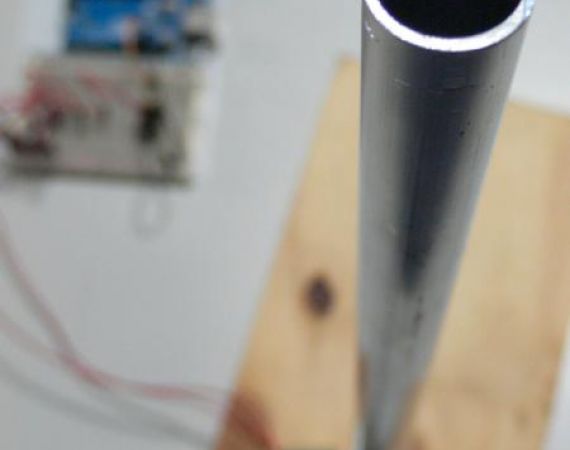Posted on Wed 20 Feb 2013
Solar Flares, Sublime Auroras & Data Visualisation
What happens when you combine art, technology, and science? As part of her Communicating Science residency, run in collaboration with IOP Publishing, Helen White is trying to find out. We joined her at the halfway point to see what she has been looking at over the past 6 weeks.Having based her…

Early experiment with electromagnetic resonance to generate sound
What happens when you combine art, technology, and science?
As part of her Communicating Science residency, run in collaboration with IOP Publishing, Helen White is trying to find out. We joined her at the halfway point to see what she has been looking at over the past 6 weeks.
Having based her previous work on natural phenomena, Helen entered into this residency keen to explore her fascination with the aurora and investigate whether it would be possible to translate solar wind data into something beautiful. So far, she has identified two possible methods of translating this data into an expressive form:
Sonic
After discovering that solar winds affect geomagnetic storms, Helen looked more closely at whether sound could be used to somehow express the velocity and density of the forces at play. Experimenting with electromagnetism, Helen created a tube that emitted a resonance when a magnet was placed nearby. She could envisage a series of instruments of varying sizes, each potentially playing a note that indicates a different level of solar activity. Considering that a large geomagnetic storm could knock out the Earth’s electronic equipment, she saw a possible application of this device as a warning system for incoming storms, varying the tone in accordance with the gravity of the risk.
Visual
While working with the Bristol-based BDH, creators of the extraordinary representations of Coronal Mass Ejections for the BBC production Wonders of the Universe, Helen began to experiment with the visual effect created by projecting particles onto sheets of clear acrylic. When placed at varying distances from each other, the acrylic gave the projections the illusion of depth, as though mapping the journey of the solar winds from the sun to the earth. Imagining being able to walk in between these sheets, surrounded by floating projected particles, Helen wondered whether her data could be visualised in an installation using similar techniques.
Joined by a table-full of brilliant minds, Helen opened up her ideas for feedback and critical questioning. Here are some of the main points that were raised:
- Science and art have very different objectives, how do you find the equilibrium between communicating science and creating an experience for the audience?
- How do you choose your audience and location? A science setting might demand interaction but a gallery could alienate audiences.
- Is there a danger of losing your artistic input while trying to communicate science? Narrative and poetry are still important; Katie Paterson translated live data of thunder storms into a string of pulsating light bulbs
- How would you make visual art out of something as sublimely beautiful as the aurora borealis? Do you need to compete or could you do something different such as make the beauty unsettling?
- Could a sonic interpretation of the aurora be informed by the urban myth that people can hear the atmospheric changes taking place 100km above the Earth?
- Could the colour intensity of the phenomenon be used to sonify the experience?
To keep up-to-date with Helen's progress, take a look at her blog which she will be updating regularly.